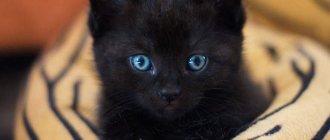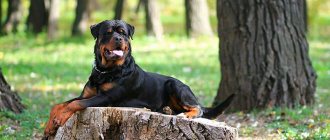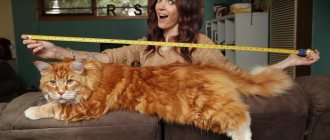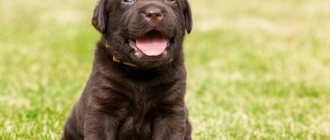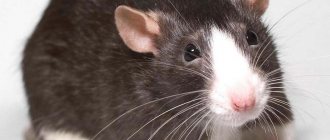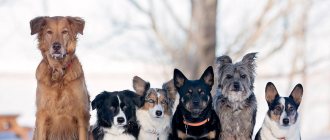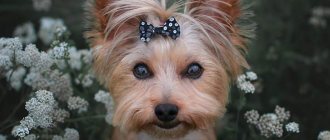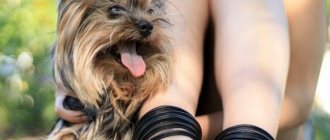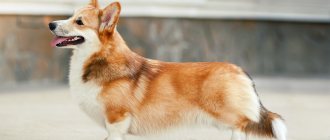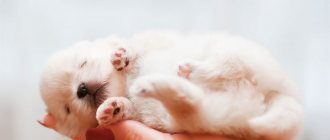One of the common questions that worries pug dog owners is whether the pet’s weight is normal or overweight? This is explained by the fact that pugs have a tendency to gluttony, which leads to obesity. The breed cannot independently control the amount of food it eats. Therefore, the owners must take responsibility for this. Drawing up a diet, determining the daily feeding rate, preventing the dog from overeating - all this should be under the strict control of the owner.
How long does it take for pug dogs to grow and gain weight? What is the normal weight for adult pets and puppies? At what indicators is a pug considered underweight and overweight? We have collected the answers to all these questions in our material.
How to measure a dog's size
To correctly measure the size of your dog you need to:
- do this at the same time of day and before the animal eats;
- the frequency of measurements depends on the age of the baby. So, at two months and earlier, measurements are taken every five days, from two to six months - every ten days, at six months and older - every month;
- Body weight is measured using ordinary scales. First you need to stand on them yourself and record the indicator. Then stand up with your pet in your arms. The difference between the two numbers is the dog's weight;
- To measure the dog's height, you need to take a measuring tape and place it vertically from the floor to the very top of the withers.
Health and illness
Pugs are not the strongest breed. Throughout their lives, they are constantly faced with hereditary and acquired diseases. How long doggies live depends directly on genetic health, care and proper nutrition. Usually pets reach 12-13 years of age, some individuals live up to 15 years.
Common diseases in pugs include:
Also, due to their brachycephalic muzzle, pugs are prone to flatulence and snoring. But the second, contrary to popular belief, is rare. Usually dogs just snore in their sleep. And during the day they puff and grunt.
Pug weight table by age
The table below shows the weight of a pug puppy by month.
| Dog age | Pet gender | |
| Male (in kilograms, +/- 400 g) | Female (in kilograms, +/- 400 g) | |
| At 2 months | 2 kg | 2 kg |
| At 3 months | 3 kg | 3 kg |
| At 4 months | 4 kg | 4 kg |
| At 5 months | 5 kg | 5 kg |
| At 6 months | 6 kg | 6 kg |
| At 7 months | 7 kg | 6.5 kg |
| At 8 months | 8 kg | 7 kg |
| At 9 months | 9 kg | 7-7.3 kg |
| At 10 months | 10 kg | 7.3-7.6 kg |
| At 1 year | 11-12 kg | 8-9 kg |
| At 2 years old | 11-12 kg | 8-9 kg |
| At 3 years old | 11-12 kg | 8-9 kg |
| At 4 years old | 11-12 kg | 8-9 kg |
How much does an adult weigh and what is considered normal?
Many dog breeders who breed this breed consider it unpretentious in care and maintenance. If your dog is fed properly, she will be active, playful, and her life will be long and fulfilling. The question of what a dog's weight should be is fundamental to its health. This is a small dog, the sizes of the male and female are practically the same. So let's look at how much should a pug weigh?
Breeders believe that for better mating and healthy, full-fledged offspring, an adult dog should weigh within the following limits: a female approximately 8.0 - 9.0 kg , and a male - 10.0 - 12.0 kg. It is recommended to weigh puppies up to 3 weeks of age every day, and then once a week.
Between the second and fourth months, the puppy should double its weight. Starting from six months, the weight gain should be a quarter. The weight of a one-year-old dog is 8.0 - 12.0 kg. Let's look at the table below by month.
Why is a pug skinny?
If your pet weighs very little, this can be explained by several reasons:
- Malnutrition. The most dangerous thing is malnutrition in puppies that are just beginning to grow.
- The dog has no appetite. There may also be reasons for this.
- Infection with worms. This is a fairly common reason. To avoid damage to the body by parasites, you need to systematically deworm your dog.
- Lack of vitamins. Again, their deficiency has the greatest impact during puppyhood. Such a baby will grow up sick and weak.
Care and maintenance
The pug is the ideal lap dog. A small apartment will suit him, and instead of a couch he will prefer to sleep with the owner on the bed. The dog will also get along outside the city, but it cannot be left in the yard for a long time or kept in an enclosure: the pet is not adapted to street life.
And if easy maintenance is a plus of the breed, then difficult care is a significant minus. Your pug needs to be constantly monitored. He is easily injured while playing or exploring the territory, and an unbalanced diet or insufficient care will lead to numerous diseases and shorten the pet’s life.
Hygiene
Pugs are naturally clean. They don't like to wallow in mud. And if they accidentally get dirty, they worry and try to clean the coat as quickly as possible. But, like any breed, doggies need regular hygiene procedures.
Key points on how to care for a pug:
Toilet
Until the post-vaccination quarantine is over, the puppy cannot be taken outside. Therefore, he is taught to go to the toilet in a diaper or in a litter tray. Fortunately, pugs are smart: in 2-3 weeks they learn to relieve themselves in the right place.
Immediately determine where the tray will always be located. Place a diaper in this area. If the room is large, place it near the bed and gradually move it to the place of the toilet.
In the first days, carefully monitor the puppy. As soon as he starts spinning in place, take him to the diaper. When he relieves himself, praise him. If your baby peed in the wrong place, don’t scold him, just soak a rag in it and put it in the toilet’s place. Wipe the puddle with vinegar or a special disinfectant.
As soon as the kitten begins to walk steadily on the diaper, put it in the tray. The first time the baby will have to be placed there, but after a couple of days he will understand what to do.
From the age of four months, pugs are taught to go outside. For the first times, take a diaper with you and lay it on the ground: the smell will tell the baby what to do. It is advisable for the dog to relieve himself first and then play.
Up to a year, the pug is taken outside often: 5-6 times a day. At this age, kids can't stand it. Therefore, a home toilet will come in handy.
After a year, pugs learn to tolerate it and can be taken outside 2-3 times a day . But the toilet at home is still useful: in case the dog cannot be taken out for a walk due to lack of time, illness, bad weather, or simply so that it relieves itself as soon as it wants.
Feeding
Proper and balanced nutrition for a pug is a key factor in the pet’s health and longevity. The breed is demanding when it comes to feeding, so this aspect is given a lot of attention.
Note! When feeding pugs, it is important to maintain the correct balance of calcium and phosphorus. Their deficiency or imbalance leads to diseases of the nervous, cardiovascular and digestive systems.
A tendency towards obesity and begging are characteristics of the breed. It is important for owners to understand that by overfeeding or giving tasty morsels from the table, they shorten the life of their pet. Therefore, the portion size is limited and the pug is not spoiled with prohibited foods: sweets, cheeses, sausages, semi-finished products, etc.
For pug puppies up to 6 months of age, the daily dose of food is 5-7% of the dog’s weight. For dogs older than six months - 3-4% of their own weight. So, if the kitten weighs 4 kg, 200-180 g, divided into several feedings, will be enough. For an adult dog weighing 8 kg, 240-320 g per day is enough.
Such calculations are followed on natural feeding. In this case, the diet consists of lean meat and offal (60%), cereals (20%), vegetables and fermented milk (15%), other products: eggs, fruits, delicacies.
Often, pug owners choose to feed them with industrial food, because the breed is picky about food and it is difficult to balance natural nutrition.
When selecting ready-made food, take into account that the pug is an allergenic breed. Therefore, diets should not contain gluten (found in wheat and corn), soy, casein (milk protein), dyes, flavors, and artificial preservatives.
Super-premium and holistic class foods meet these requirements. The best brands for pugs:
Additional Information! Some pugs are allergic to chicken. Therefore, look for ready-made food without this ingredient or with poultry raised using organic raw materials, without hormonal additives.
You can also choose food to suit your pet’s specific needs. Typically, pugs need hypoallergenic food for teeth cleaning, sensitive digestion, or weight control.
Walks and trips
The pug is considered a classic couch dog. Because of this myth, many owners neglect physical activity. But this approach is fatal. The breed has developed muscles. Lack of movement leads to poor circulation and muscle atrophy. Plus, without regular exercise, dogs quickly gain weight, the excess of which affects their health.
Walks should be daily. However, long walks and intense games are prohibited. Pugs get tired quickly, and the structure of their muzzle does not allow them to effectively cool the body and fully saturate the blood with oxygen during exercise.
Obesity in pugs
This is a very common problem in Pugs. Therefore, the owner should not give in to slack and treat the pet with food from his own table. Pugs are small dogs, so they gain excess weight quickly. Starting from a young age, the puppy should eat only according to a strict schedule, without unscheduled “snacks”. In order not to miss the onset of the disease, it is necessary to systematically weigh the animal.
However, the cause of obesity is not always severe overeating. Sometimes this is facilitated by disturbances in the functioning of the endocrine system, lack of physical and physical activity, and old age.
Pugs love to eat, they can do it all day long. Surely, when you sat down at the table for dinner or simply decided to snack on something tasty, you noticed how a pug immediately appeared next to you with such an unhappy expression in his eyes that it was simply impossible to resist. Don't fall for the dog's tricks. It’s worth sharing a piece of something tasty once, but in the future the pet will simply sit on your neck and get used to begging for food.
From the very beginning, strictly ensure that no one from the household gives the “poor hungry dog” a single piece from the table. A piece a day will lead to plump barrels in a couple of months. Read here what to feed your pug. Feed the animal correctly, following the diet.
Pugs are muscular and quite dense dogs, but they should not have excess fat. Excess weight will lead to cardiovascular diseases, which will negatively affect your pet's life expectancy.
Your pug gains excess weight unnoticed; try to weigh your pet monthly.
Diet tips
Feeding pug puppies
Veterinarians and dog handlers advise feeding small puppies with ready-made dry food, as it contains a properly balanced amount of vitamins. Around seven months or a little earlier, you can gradually switch your baby to natural food (if desired).
If the owner decides to feed the puppy natural products, he must correctly calculate the daily portion and do not forget about adding vitamin complexes to the diet.
If the owner decides to feed the baby food, you need to buy products of at least premium class, since economical budget granules are dangerous to the health of the animal.
Nutrition for an adult dog
The pug does not have chewing teeth, so it is necessary to cut meat and other food given to the pet into pieces. Meat should be cut larger, other products smaller.
In general, the pug diet should look like this:
- Raw lean meat - at least 2/3 of the entire diet.
- Boneless fish (only sea and lean fish) – 1-2 times a week.
- Sour milk - every day.
- Boiled vegetables, finely chopped fruits - every day.
- Thick buckwheat, rice and oatmeal porridges – 1-2 times a week. It is allowed to season with a piece of butter (or a spoonful of vegetable oil).
You cannot mix natural food with dry ready-made granules. Prohibited foods for dogs are:
- pasta and other flour products, including bread and pastries;
- semolina;
- fatty foods;
- smoked food;
- potatoes in any form;
- sugar and sweet products (sweets, lollipops, etc.).
What affects the development of a puppy?
Pugs usually gain weight quickly in the first couple of months. Genetic and hereditary factors have a great influence on the weight of a pug. Other factors influencing the development of puppies are the environment - pugs that feed well on breast milk in the first weeks of life are likely to develop and grow faster and larger.
It is also necessary to create a special diet for pugs to avoid future problems with excess weight.
Puppies need to be fed more often and more than adult animals, as they expend more energy during the growth period. Adult dogs of this breed need to be fed less often and less.
A balanced diet and physical activity are the key to your pet’s well-being.
The above data on the weight of puppies may fluctuate between 300-500 g above or below the norm - this is normal.
NOTE!
The pug is a dog that requires specific care. Careful selection of food for your pug will help him stay in good shape and in a great mood. In addition, daily walks with your pet are necessary to ensure that he does not develop rickets.
The diet should consist of milk porridges, vegetables, thick soups with meat and vegetables, cottage cheese and eggs.
Diet for Overfed Pugs
Diet is the main weapon in the fight against obesity in your pet. And to use it effectively, you need to know the rules for creating a healthy dog diet:
- It is strictly forbidden to give an overweight pug the usual canned food. The exception is a special dietary one, which contains a full range of nutrients.
- Reduce your daily food intake by 10%. We divide the number of feedings by four per day instead of the usual two. If the pet has become obese due to old age, then the frequency of feedings, on the contrary, decreases to once a day, or remains usual - twice a day. In the morning, the old pug is given light food like egg yolk or vegetables and porridge. And in the evening they give you lean fish or poultry.
- Among the permitted products are: white poultry meat, lean fish, kefir and other fermented milk. In addition, you need to increase your consumption of vegetables.
- It is necessary to add vitamins and minerals to the baby’s daily diet.
Another component of treating obesity in a pet is increasing activity. The duration of daily walks should not be less than an hour. You need to unfasten the leash more often and let the baby run freely. Active games will also come in handy. For example, with a ball or a stick. Veterinarians recommend sending your baby swimming, because while swimming in the water, he receives an even load on all muscles. But if the pug doesn’t like water, you can’t insist.
Education and training
Pugs are smart and pick up commands on the fly. Therefore, in the first weeks of a puppy’s life in a new home, he can be taught basic orders: “Ugh,” “No,” “Come to me,” “Place,” “Stand,” “Sit,” “Lie down.”
The first thing a pug kitten must learn is its name. Without this, subsequent training will not be effective. The second most important lesson is the commands “Fu”, “No” and “Drop”. The dogs are friendly and curious, picking up food from the ground and taking treats from the hands of strangers. Knowing the prohibitory orders will protect your pet from poisoning and harmful treats.
Mastering more complex commands is difficult. The pug breed is stubborn, does not like to obey, and is often on its own mind. Therefore, you will have to make a lot of effort to train a small Molosser.
If you are at a loss on how to raise a pug, be consistent. Even if your pet doesn’t master the command for weeks, don’t give up: one day he will understand everything and will obey. Be patient. Stubborn monkeys can be won over with affection and constant encouragement. Any punishment during education is unacceptable, even raising your voice is prohibited. You can only scold your pet if he does something wrong.
History of the breed
These small dogs have been living next to humans for more than 3,000 years. The first images and mentions of them in history date back to the 6th century BC. e. - at that time they were getting divorced in China and living in the palaces of the nobility. The Chinese saw hieroglyphs in the folds on the foreheads of these dogs, considering this an imperial sign. Therefore, they often lived better than ordinary people: they had their own rooms and servants. Ancient pictures show that they were carried on stretchers to prevent overwork.
Pug face
In China, these dogs were described as square, low, with a short muzzle, they were short-haired, unlike the long-haired ancestors of the Pekingese. Pugs were highly valued and expensive. They appeared in Europe in the 16th century and rich people also began to keep them. Many pictures of noble ladies holding such a pet on their laps have survived to this day. It was believed that they loved pug dogs because of their wrinkled face, which made them look like monkeys.
Gradually the breed spread to Europe. Pugs were first bred in Holland, then they were brought to Great Britain, France and other countries. But in the 18th century they became no longer so popular; they were started by merchants, merchants and even ordinary people. Therefore, pugs were in danger of degeneration. When, in the second half of the 19th century, Queen Victoria wanted to have this cute pet, she could not find a purebred puppy, so these dogs were again imported from China.
They began to be bred in Great Britain, and by the end of the 19th century the first mops club appeared. At the same time, a breed standard was created. Unlike Chinese dogs, European dogs have become short-legged, powerful, with a short nose, and larger in size.
These dogs came to Russia only at the beginning of the 20th century. But because of the revolution and two wars, no one dealt with them. Only in the 80s of the 20th century were the first pugs from the GDR brought to Moscow. After this, their breeding began. Over the past few years, the pug has been one of the most popular decorative breeds all over the world.
You can watch the video in more detail about the pug breed:
Price
The cost of puppies depends on the region of purchase, age, color and pedigree. The price of dogs of ordinary colors (red, beige, silver) is 10,000-12,000 rubles, and small black pugs cost from 15 thousand to 20 thousand.
Pet-class puppies without a famous family are purchased for 10,000-15,000 rubles. The presence of a pedigree, documents, and the dog’s compliance with all standards increases this figure to 20,000-60,000 rubles.
Most nurseries have websites where they post photos of animals, supplemented with all the necessary information about them. Buying a pug online reduces the price to 8,000-9,000 rubles.
Breed traits
Breed traits (on a 5-point scale)
| Pug | |||
| Activity | in the house | 2.7 | |
| on the street | 3.2 | ||
| Obedience | training | 3.1 | |
| strangers | 3.4 | ||
| Domination | in family | 1.6 | |
| over dogs | 2.2 | ||
| Defending your territory | from people | 1.6 | |
| from dogs | 2.1 | ||
| Sociability | in family | 4.4 | |
| with strangers | 4.2 | ||
| with dogs | 3.6 | ||
| Concentration | in family | 1.4 | |
| in front of strangers | 1.4 | ||
| with dogs | 1.5 | ||
| Aggressiveness | in family | 1.2 | |
| to strangers | 1.3 | ||
| to the dogs | 2 | ||
| to cats | 1.9 | ||
| Family behavior | calmness | 3.8 | |
| demand for affection | 4.4 | ||
| excitability | 4.2 | ||
| playfulness | 4.3 | ||
| excessive barking | 2.4 | ||
| behavioral breakdowns | 1.8 | ||
| Tolerance for children | up to 4 years | 4 | |
| over 4 years old | 4.3 | ||
| Institutional use | watchman | 3.5 | |
| bodyguard | 1.2 | ||
This breed is often compared to the following dog breeds: Pomeranian, Pembroke Welsh Corgi, Yorkshire Terrier, French Bulldog, Pekingese.
Sticks his nose into everything
When talking about the character of a pug, they use the following words: charming, noble, intelligent. And this has already said a lot. Special qualities of a companion are also noted. Thanks to its cheerful activity, the decorative dog always attracts the attention of others. And he likes it. He jumps, plays and sticks his nose into all household chores with great pleasure. At the same time, he completely sincerely shows his wonderful mood.
This behavior is absolutely normal for an ideal pug. He is exactly how he should be: lively and cheerful. However, as a characteristic quality, his balance in actions is noted. He is often called a “couch dog,” which is quite justified, because he also loves to sleep next to his owner.
Unacceptable vices are manifestations of malice, cowardice, and hysteria.
Prohibited Products
Many loving owners pamper their beloved pugs with prohibited foods, unaware of the sad consequences of such treats. To avoid the development of bad habits and serious pathologies, it is highly recommended not to feed your nimble baby the following foods:
- Sweets. Cunning fatties love sweets very much, but you should not feed your beloved kids sweets and cakes to avoid the destruction of tooth enamel, the development of diabetes and obesity. An alternative sweet treat for pugs is honey and fruit, which meet the growing body's glucose needs.
- Smoked meats, sausages and spicy foods. Seasonings and preservatives contained in sausage and smoked products contribute to the development of gastritis and gastroenteritis in young dogs.
- Pork, fatty and fried foods. Fatty foods with prolonged feeding can cause irreversible degenerative changes in the animal’s liver.
- Bones. The common belief that a puppy should be treated to bones is erroneous. It is highly recommended not to give pugs bird and rabbit tubular bones to avoid damage to the thin intestinal lining from the sharp edges of the bones. Boiled bones thicken stool and cause constipation. Babies can be given small soft lamb and veal bones, previously beaten with a hammer, or a large beef sugar bone.
Standard
Pugs, according to the standard, belong to the decorative and companion breeds. They are classified as small molossoids; among small dogs they are closest to mastiffs. The fact that they have a powerful physique can be seen from any photograph.
Pugs sizes
From the photo of the pug you can tell that this is a small dog. The female’s height is 25-30 cm, weight – up to 8 kg. Males are 30-35 cm tall and can weigh from 6 to 10 kg.
Color options
The most common colors of pugs are beige, apricot, and platinum. The first pugs in Europe were exactly like this. And until the end of the 19th century, other colors were not recognized, and the black color was considered a defect and such puppies were destroyed. Nowadays the black pug is becoming more and more popular.
Pug
Light colored dogs should have different patterns and markings. Most often this is a black mask on the face and ears, but there may be dots on the forehead or cheeks, a stripe along the back, and darker claws. Pure white color is a breed defect.
Wool
Pugs have short, shiny and smooth fur. It may be a little shorter on the muzzle. The coat is not hard, but not fluffy, and lies tightly to the skin. They shed twice a year, which is why many people experience allergies.
Head
Pug dogs have a large, round head. In front it is covered with folds, which are a characteristic feature of this breed and form a special symmetrical pattern. But they are located mainly on the forehead, and do not hang down on the sides of the muzzle.
Pug ears are small and triangular. Previously, they were docked, but since the end of the 19th century this has been abandoned. Therefore, the ears can either hang down, covering the auricle, or open it a little.
Muzzle
A characteristic feature of pug dogs is their short, slightly flattened muzzle, similar to a bulldog. But they only have a small undershot; their teeth and tongue are not visible. The lower jaw is wide and straight.
The nose is not turned up, the nostrils are large. The bridge of the nose is short, straight, covered with a fold, and the nose is always black. The nasal passages are not crooked, so breathing problems are less common than in bulldogs.
Pug nose
When looking at the dog from the front, the muzzle should be flat and wide. It should not be upturned or down. Hanging folds and protruding lower jaw are unacceptable.
The pug's eyes are round, large, widely spaced, and located in line with the nose. They should not be light or too convex. They are characterized by a meaningful expression that changes depending on the situation. Looking at the photo, you can always understand what mood the dog is in. They can be sad, cheerful, mischievous or wise.
Torso
The Pug is a small but balanced dog. The body is muscular, stocky, compact. It should not be too thin or, on the contrary, thick. The dog's height should be approximately equal to its length. The skin is elastic and gathers into small folds.
The neck is thick, powerful, slightly curved with a pronounced scruff. The chest is quite wide. The back is straight and muscular.
Pug and cookies
Pugs have a short tail, curved into a ring. He is set high, so he almost lies on his back. According to the standard, a double curl of the tail is desirable.
Limbs
Limbs are straight and strong. They are parallel, located directly under the body. The feet are small and the toes are well separated. The gait is confident and springy. Joints with clearly defined angles.
Varieties
When breeding pug dogs, they try to preserve the breed characteristics. But now there are three varieties:
- terrier type – more graceful build, elongated neck;
- bulldog type - thick short legs, wide body, slightly protruding lower jaw;
- Shar Pei type is characterized by an abundance of folds throughout the body.
Vices
Some puppies are born with defects that do not meet the standard. Such dogs are not allowed for breeding and are considered a waste. Some of the defects do not affect the behavior and health of the dog. Therefore, she can still become a good friend to a person who does not care about documents. What deficiencies will not give you a pedigree:
- convex skull, protruding forehead;
- absence of the bridge of the nose, a large or small fold on it;
- upturned nose, inverted or narrow nostrils;
- hanging folds, especially on the cheeks;
- light-colored, small or close-set eyes;
- teeth or tongue visible when mouth is closed;
- disproportionate body - too elegant or fat, long neck, sagging breasts;
- The coat is long, fluffy, white in color.
First vaccinations
Vaccinations for puppies begin at 7-11 weeks. 10 days before the immunization procedure, deworming is carried out with anthelmintic drugs. Repeat the course of treatment with antiparasitic drugs every 4 months.
First, puppies are given a 5-valent injection for hepatitis, leptospirosis, distemper, parvovirus and adenovirus. After 4 weeks, the dogs are revaccinated against 5 infections carried out at eight weeks of age, supplemented with a remedy for parainfluenza. The anti-rabies drug is used annually.
Before vaccination, you should not take your pet outside. It is allowed to walk the pug in the summer in the arms of the owner. 10 days before vaccination, contact with animals is prohibited. The procedure can only be postponed during illness or when the dog’s baby teeth are changing.
After vaccinations, the puppy sometimes experiences general malaise, swelling and pain in the injection area, increased body temperature, and lethargy. If symptoms persist for more than 3 days, it is worth visiting a veterinarian.


